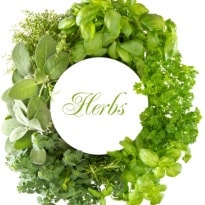How can you possibly resist a sprinkle of fresh coriander on your daal, soup or chicken curry? How can you not have a bowl of mint sauce (popularly known as pudina chutney) stacked away in your fridge?Believe it or not but fresh herbs can make or break a dish. A good pesto can fall flat without fresh basil and a South Indian curry can never be complete without freshly plucked curry leaves. Yes, using prepackaged dry herbs is always an option but can it ever come close to the real thing?Whether you've got a roomy garden or a small kitchen balcony, growing your own fresh herbs is extremely easy and we're going to show you how.
CorianderCoriander, dhania or cilantro is an everyday herb used in almost all Indian households. It's refreshing, light and partners brilliantly with all Indian food. (Recipe: Dhania chutney, Dhaniya Murg, Coriander-Cheese Kebabs)Grow it right: Sow the coriander seeds about half inch deep in soil and leave a gap of approximately 6 inches between them. Water them every alternate day and you should have a fully grown bush of green dhania in about 10 days.When to grow: Coriander doesn't fancy hot weather but still needs the sun. Place the pot in a place where it gets adequate sunlight and water it every day. Be sure to not over-water the plant at any point. February and March are considered the best months for growing coriander.
BasilBasil is a warm season herb of pungent nature that makes it suitable for both sweet and savoury dishes. You can blend it with pine nuts and garlic to make smashing pesto or lace it on some chilled pannacotta - basil is a real superstar. (Recipe: Pesto, Pesto Chicken, Tomato and Basil Sauce)Grow it right: Basil need warm weather and less water. Plant three to four seedlings in a pot and put it in a place where it gets the right kind of sunlight (not too much and not too little). A few weeks later, transfer it to bigger pots and let it grow. When the plant is about 2 inch tall start to pluck the leaves and eat them as and when you want. Plucking them encourages the plant to grow further.When to grow: Plant the seeds in February or March and transfer them to bigger pots in April.Curry LeavesCurry leaves brings to mind the crackling sound of the leaves being fried in oil. Prolonged cooking of curry leaves ruins their taste which is why you'll see them fresh and rested on top of many North Indian as well as South Indian dishes. (Recipe: Curry leaves chutney, Kerala Fried Prawns)Grow it right: A curry leaf plant needs abundant sunlight. So keep them under direct sunlight for most part of the year but keep them away in hot summers. While seeds work well, stem cuttings (about 3 inch long) are the easiest way to plant curry leaves. Sow the stem a few inches into the soil and put some leaves above the surface. Be sure to not let the soil be dry at any point in time (but also not too wet). It's also important to trim curry leaves regularly to allow space for more of them to grow.When to grow: Any time of the year. Just be careful to not keep it under the sun during arid summers.
LemongrassLemon grass is a gorgeous lemon-citrus herb that is fresh, green and packed with a tangy punch. It is absolutely essential to Asian cuisine and also used very often in cocktails. The thick and juicy ones come more recommended over the thin and limp ones. (Recipes: Lemongrass Tea, Chicken Lemongrass Chilli)Grow it right: Lemongrass is probably one of the easiest things to grow at home. Buy a few stems from the market and throw them in a jar of water (1-2 inch of water). Change the water every day till the lemongrass grows about 2 inch tall (2-3 weeks later). Then transfer it to a pot and keep it hydrated.When to grow: Grows better during the winter but can withstand the summer if grown in minimal heat.
TulsiA Hindu household is considered incomplete without the quintessential Tulsi plant. It's of great cultural and medicinal value which is why it is considered every Indian's go-to herb.Grow it right: The Tulsi plant needs rich and moist soil and abundant sunlight. Plant the just a few centimeters below the soil with a light cover of dirt. Let it grow indoors or in some greenhouse protected area for about four to eight weeks. When they're about 6-7 inch tall transfer them to bigger pots and let them grow outdoors.When to grow: Tulsi should be planted right before the monsoon, under intense heat and allowed to grow through the rain and cooler climate.
CorianderCoriander, dhania or cilantro is an everyday herb used in almost all Indian households. It's refreshing, light and partners brilliantly with all Indian food. (Recipe: Dhania chutney, Dhaniya Murg, Coriander-Cheese Kebabs)Grow it right: Sow the coriander seeds about half inch deep in soil and leave a gap of approximately 6 inches between them. Water them every alternate day and you should have a fully grown bush of green dhania in about 10 days.When to grow: Coriander doesn't fancy hot weather but still needs the sun. Place the pot in a place where it gets adequate sunlight and water it every day. Be sure to not over-water the plant at any point. February and March are considered the best months for growing coriander.
BasilBasil is a warm season herb of pungent nature that makes it suitable for both sweet and savoury dishes. You can blend it with pine nuts and garlic to make smashing pesto or lace it on some chilled pannacotta - basil is a real superstar. (Recipe: Pesto, Pesto Chicken, Tomato and Basil Sauce)Grow it right: Basil need warm weather and less water. Plant three to four seedlings in a pot and put it in a place where it gets the right kind of sunlight (not too much and not too little). A few weeks later, transfer it to bigger pots and let it grow. When the plant is about 2 inch tall start to pluck the leaves and eat them as and when you want. Plucking them encourages the plant to grow further.When to grow: Plant the seeds in February or March and transfer them to bigger pots in April.Curry LeavesCurry leaves brings to mind the crackling sound of the leaves being fried in oil. Prolonged cooking of curry leaves ruins their taste which is why you'll see them fresh and rested on top of many North Indian as well as South Indian dishes. (Recipe: Curry leaves chutney, Kerala Fried Prawns)Grow it right: A curry leaf plant needs abundant sunlight. So keep them under direct sunlight for most part of the year but keep them away in hot summers. While seeds work well, stem cuttings (about 3 inch long) are the easiest way to plant curry leaves. Sow the stem a few inches into the soil and put some leaves above the surface. Be sure to not let the soil be dry at any point in time (but also not too wet). It's also important to trim curry leaves regularly to allow space for more of them to grow.When to grow: Any time of the year. Just be careful to not keep it under the sun during arid summers.
LemongrassLemon grass is a gorgeous lemon-citrus herb that is fresh, green and packed with a tangy punch. It is absolutely essential to Asian cuisine and also used very often in cocktails. The thick and juicy ones come more recommended over the thin and limp ones. (Recipes: Lemongrass Tea, Chicken Lemongrass Chilli)Grow it right: Lemongrass is probably one of the easiest things to grow at home. Buy a few stems from the market and throw them in a jar of water (1-2 inch of water). Change the water every day till the lemongrass grows about 2 inch tall (2-3 weeks later). Then transfer it to a pot and keep it hydrated.When to grow: Grows better during the winter but can withstand the summer if grown in minimal heat.
TulsiA Hindu household is considered incomplete without the quintessential Tulsi plant. It's of great cultural and medicinal value which is why it is considered every Indian's go-to herb.Grow it right: The Tulsi plant needs rich and moist soil and abundant sunlight. Plant the just a few centimeters below the soil with a light cover of dirt. Let it grow indoors or in some greenhouse protected area for about four to eight weeks. When they're about 6-7 inch tall transfer them to bigger pots and let them grow outdoors.When to grow: Tulsi should be planted right before the monsoon, under intense heat and allowed to grow through the rain and cooler climate.
Advertisement





